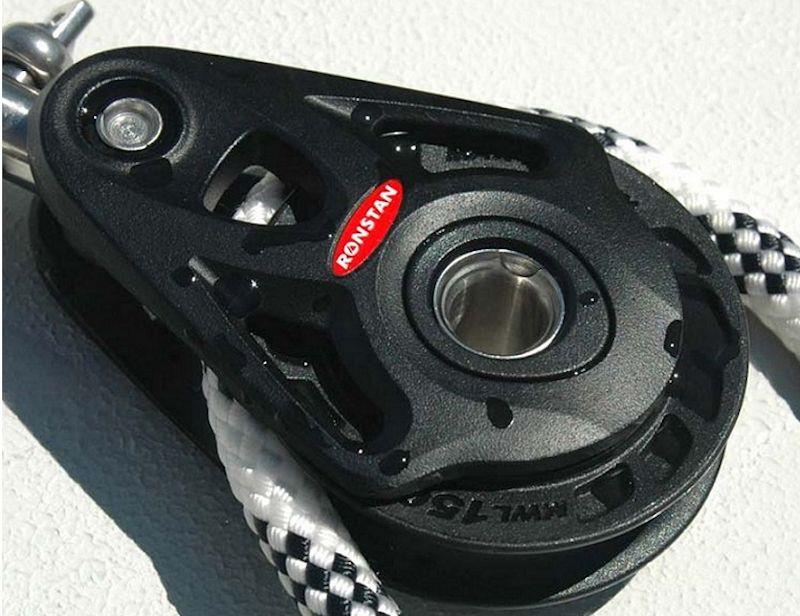
Sailing Blocks, a Basic Glossary
by Diego Sosa, Upffront 2 Aug 2018 08:00 UTC

Ronstan Core Block © Ronstan
Different types of sailing blocks have been designed to cover all types of sailing controls. But, do you know your Fiddle from your Becket? The following definitions, or in this case a "blockssary", will help you understand basic block terminology.
Sheaves
Blocks can have single, double, triple and even quadruple sheaves. Sheaves are orientated side by side; multiple sheaves keep block sizes and weights to a minimum and are normally used as part of purchase systems.
Sheave Arrangement
A fiddle is an additional, normally smaller, sheave used to reduce the width of the purchase system. The becket is an anchor point under the main sheave, which is used as the starting point for the end of the line. A becket can also help maintain the orientation of the block, using an additional lashing line.
Attachment options
Shackles
Traditional metal shackles still provide the best solution for many applications. Different metal shackles such as long, short and twisted, get the correct block placement/orientation. A key consideration is whether the head of the block is fixed or swivelling. Changing the angle of the load normally requires a swivelling head.
Snap Shackle
One or two snap shackle blocks should always be available for emergency use. Their quick -release opening mechanism enables them to be easily placed anywhere onboard, but they are only suitable as a temporary solution.
Rope shackle / Lash / Soft loop
A rapidly rising trend in block technology. A Dyneema® rope shackle, loop/strop is placed through the centre of the block. This "soft attachment" is lightweight and does not corrode.
It never binds under load and it is stronger than its metallic equivalent. Also, safer--- if the block itself fails, the line is held by the rope.
Oh.... and they also self-align to the load angle, which reduces fatigue.
Can you tell we are fans!?
Application-specific blocks
Snatch Block
Often found in conjunction with a snap shackle attachment, the cheeks of a snatch block swivel apart, allowing the block to be placed on a pre-loaded line. Snatches provide various options in expected and unexpected situations, like failing blocks, or changing headsail.
Foot / Cheek Blocks
Even industry professionals debate about whether there is a difference between them. Both are side mounted to the deck or mast and locked in place with bolts. Their purpose is to change line direction. Foot blocks are usually mounted on the deck and go higher up the load range. 'Cheek' is a name used by mast makers for similar, smaller blocks. Either can be used in most situations but loads and deflection angles must be considered carefully – a line deflected 180 degrees will exert a significantly higher load than that of 30 degrees.
Cleats (fixed or adjustable)
Integrated cleats hold the line in place. A vang or cunningham system will often have a block with a cleat attachment for quick and simple control. The other common use for cleat blocks are mainsheet systems on small boats, but they tend to be on adjustable arms. This is to be able to change the angle of the mainsheet.
Wire Blocks
A lot less common nowadays, these blocks are meant to be used with wire and they have narrower sheaves. Currently found in some vang, backstay and halyard applications.
Halyard Blocks
Specifically designed for attachment at the mast base and turning lines through 90 degrees.These are single, high load blocks which can stagger, neatly around the mast.
Lead Blocks
Lead blocks efficiently manage lines and minimise friction, as they find their away long decks or down masts, from "the business end" back to the cockpit. Some are stanchion base mounted, others lead the line through the deck or mast laminate. Frequently, they are mounted on tracks for genoa sheet leads.
Runner Blocks
Used for running backstays so that the mast bend can be adjusted for different types of wind conditions. They have a primary, backstay attachment points and two others: one forward for upper / lower checkstays and one aft, often used as a retaining system to stop the block from flying around.
Wide Blocks
Exceptionally wide sheave diameters allow two lines to loop around simultaneously, however, only one line can be loaded at the same time. Yeah, that sounds great and all, but so what? There are various applications onboard where this can be useful. One example would be running heavy-air and light-air spinnaker sheets through the same turning block. In heavy air, both sheets can be attached no problem but when the wind drops the heavy sheet can be taken off the sail without having to lead a new sheet.
Ratchet
As its name suggests, the main function of this block is based upon its locking mechanism which holds part of the load and allows better overall control of a constantly trimmed sheet or control line. The ratchet provides the "best of both worlds", in the sense that it assists the trimmer maintain load, while, at the same time, it can be trimmed freely.
Try to identify all of these different types of blocks at upffront.com!